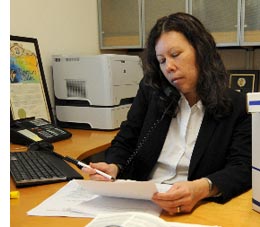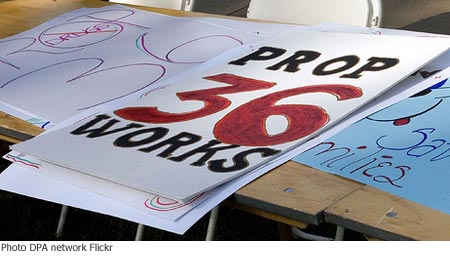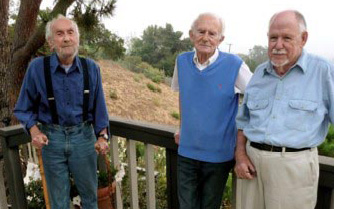Blazing a new eco trail
October 27, 2009
You might think of them more as tree-savers than tree-huggers. But members of the Los Angeles County Fire Department are getting high marks for the eco-friendly landscaping at Station 65 in Agoura. And that’s just the beginning.

A California live oak surrounded by water-saving landscaping outside County Fire Station 65 in Agoura
The changes so far are subtle but important.
Grass has been replaced with artificial turf, organic mulch and rock ground cover in the new design, sketched out by Ronald M. Durbin, a deputy forester in the fire department’s Malibu Forestry Unit. There are roses around a memorial monument in front of the station, but the rest of the new planting emphasizes native plants, such as oak, sycamore and walnut trees as well as drought-tolerant ornamentals. The irrigation system is super-thrifty—with water directed at individual plants instead of spraying wide areas.
The new look caught the eye of the Las Virgenes Municipal Water District, which in June awarded the station its citizen of the month award. “Somebody did a good thing,” says Jeff Reinhardt, the district’s public affairs and communications manager. “You don’t have to have the lush green stuff, you know.”
The landscaping makeover is a small part of a bigger environmental push. Next up for station 65 and nearby station 67 are low-impact development retrofits—the first such makeovers to test-drive new water-saving, pollution-fighting requirements mandated for new development in the county. (Learn more about LID here.)
 The goal of the program, essentially, is to keep rainwater from running off the property to replenish ground water supplies and, when possible, be reused for onsite irrigation. That means creating a new “bioswale planting area” and adding permeable paving, a planting area for gray water use, a cistern and even a rain barrel.
The goal of the program, essentially, is to keep rainwater from running off the property to replenish ground water supplies and, when possible, be reused for onsite irrigation. That means creating a new “bioswale planting area” and adding permeable paving, a planting area for gray water use, a cistern and even a rain barrel.
The LID improvements, to be funded with $872,000 in county funds appropriated under the leadership of Supervisor Zev Yaroslavsky, are expected to be approved by the Board of Supervisors on November 17 and should be in place by next year.
The Fire Department understands the need to be a positive environmental role model, says Durbin, who also has degrees in landscape architecture from Cal Poly Pomona.
“We’re in the public eye every day, so we need to set an example,” Durbin says.
That’s why the water district was eager to seize on the fire station as a public statement of water-thriftiness, done in an attractive way.
“It’s adjacent to the Paramount Ranch area but it’s also adjacent to some estate properties, and the folks who drive by there every day are going to see that,” Reinhardt says. “The statement it makes has got a lot of impact. It’s not only saving water but it blends more with the area. You’ve got this very water-wise projection into the community.”
Of course, as drought penalties for overuse kick in, the district also can get profligate users’ attention the old fashioned way. “About three weeks ago, we sent out a bill for $12,100 for a two-month billing cycle,” says Reinhardt of the Las Virgenes Municipal Water District. “The old model is just not sustainable.”
Prop. 36 treatment dollars up in smoke
October 22, 2009
In theory, it was a win-win.
Nine years ago, California voters overwhelmingly approved a measure to put low-level drug offenders on a path to rehabilitation while potentially saving taxpayers huge sums in jail costs.
Proposition 36 guaranteed non-violent drug and alcohol abusers the right to enter community-based treatment programs in lieu of incarceration. Since its passage, a yearly average of more than 50,000 individuals statewide has opted for the program, more than 25% of them in L.A. County.
Today, however, the alternative-sentencing program is imperiled, a victim of California’s budget mess. State legislators, faced with a gaping deficit this summer, eliminated the measure’s $120 million budget, forcing California’s hard-pressed counties to confront the consequences.
Although the state has appropriated $18 million in other treatment monies and has held out the possibility of giving counties millions more in federal stimulus funds next year, the impact on L.A. County has been swift and severe. In late September, the Board of Supervisors was forced to sign off on a stunning 80 percent reduction in Prop. 36 treatment services.
“The law will still be on the books. People will still be looking for treatment. But the treatment won’t be there for many of them,” says Nicholas Vrataric, executive director of the Clare Foundation, a Westside treatment center.
Some of the fallout so far:
- Nineteen Prop. 36 drug courts have been shut down because of the slashed state funding. The Probation Department, for its part, is no longer assigning officers to misdemeanor offenders, who represent about 30 percent of total participants in Prop. 36 programs, or to centers where violators are assessed for the kind of treatment they need.
- The waiting list for Prop. 36 treatment is swelling and expected to hit around 5,000 by year’s end, says John Viernes Jr., director of the county Public Health Department’s Alcohol and Drug Program Administration. Until recently, it was zero.
- Weekly drug tests for Prop. 36 defendants have been cut to once every two weeks.
- County health officials have begun urging providers to offer treatment alternatives that cost far less than the residential and out-patient plans currently being used. Many treatment centers, however, say they’re not yet skilled in providing these alternatives and question their effectiveness.
From its earliest years, studies have shown that Prop. 36 has saved substantial sums in prison costs, with about a third of participants completing treatment—roughly the same rate as for people outside the criminal justice system who’ve sought treatment, according to UCLA researcher Darren Urada, principal investigator for an annual statewide study of Prop. 36. In L.A County, the completion rate is even higher, about 46 percent.
Still, many government players in the criminal justice system have dismissed the program as little more than a get-out-of-jail-free card, an ideal that has fallen far short of its promise to reduce substance abuse and recidivism.
Superior Court Judge Peter Espinoza, supervising judge of the criminal branch in Los Angeles, says that “at any given time, 57 percent of the felons eligible for Proposition 36 have a bench warrant outstanding,” indicating they aren’t reporting their progress to the court as required. “We consider it one of our least successful endeavors,” he says.
Scott Stickney, a Probation Department official, says that up to 70 percent of traditional, non-Prop. 36 defendants successfully complete treatment and probation, a much higher rate than for Prop. 36 participants. Stickney argues that the measure lacks the kinds of consequences, such as jail time, that many drug offenders need as motivation to complete treatment and probation.
The truth is that no matter what the funding levels or criticisms, Prop. 36 remains the law of the land, guaranteeing certain drug offenders a right to opt for substance abuse treatment rather than jail. And that has left the county’s public health and probation officials scrambling to stretch very scarce dollars.
Viernes, of the county’s alcohol and drug program, says one goal is to find ways to lower treatment costs, without sacrificing effectiveness, so that large numbers of Prop. 36 clients can still be accommodated. That may mean shortening residential treatments from 90 days to 60 days for some clients, he says, or sending them to cheaper outpatient programs or sober living homes, which would cost far less.
But the Clare Foundation’s Vrataric is one of many providers who worry that if treatment programs are cut too much, they might become ineffective. “I think the provider community has to push back,” he says. “In good conscience, that’s not good public policy.”
The county also is determined to try to line up other sources of funding for providers serving the Prop. 36 population.
And that’s welcomed news for providers such as Kathy Watt, director of the Van Ness Recovery House in Hollywood, which specializes in gay, lesbian, bisexual and transgender addicts. The 20-bed facility has seen its county grant money already cut from $51,000 to $9,736.
“By the end of the month, we’ll be done with the funding” she said in a mid-October interview.
To compensate for the funding drop, Watt says she and other staffers took a 20 percent pay cut and vows not to turn away clients seeking the center’s specialized treatment. “We’ll find funding somehow,” she says.
Feds help you save green on solar panels
October 22, 2009
Federal stimulus money is on the way to Los Angeles County for a program that will make it easier for homeowners and businesses to finance the installation of solar panels on their roofs.
 The $15.4 million Energy Efficiency and Conservation Block Grant, awarded at the end of September, will pay the set-up costs for a loan program to make solar panels, weatherizing and other clean-energy retrofits affordable to residents and businesses in unincorporated county areas. (Talks are underway for cities to opt in to the county’s plan soon, too.) Without the stimulus money, the county lacked the funds to set up the program, says Howard Choy, director of energy program at the county’s Information Services Department.
The $15.4 million Energy Efficiency and Conservation Block Grant, awarded at the end of September, will pay the set-up costs for a loan program to make solar panels, weatherizing and other clean-energy retrofits affordable to residents and businesses in unincorporated county areas. (Talks are underway for cities to opt in to the county’s plan soon, too.) Without the stimulus money, the county lacked the funds to set up the program, says Howard Choy, director of energy program at the county’s Information Services Department.
Once the program is up and running, the county will make low interest loans, funded by municipal bonds, to property owners, who will pay back the county over time through their property tax bills. That easy-payment mechanism will eliminate the upfront costs that are a major impediment for property owners who want to go green but lack the upfront funds for costly clean-energy retrofits.
Didn’t know about the federal stimulus grant? You can find news about all of the county’s federal stimulus grant applications at its Stimulus Funding website. Scroll down to the Status of County ARRA Grant Applications (or click here) and you’ll find a scorecard of every grant application the county has made under the American Recovery and Reinvestment Act of 2009, President Obama’s $787 billion federal stimulus plan better known as ARRA.
The county’s scorecard lists all of the 39 grants totaling $368 million that the county has won, including for programs to boost spending on food stamps and homelessness. The site also lists grant applications that are filed but still pending, along with those that were denied, such as one to retrofit 128 aging diesel county Public Works work vehicles with pollution-cutting devices.
Much of the money comes in “primary” grants made directly to the county or one of its agencies. Also listed are “secondary” grants made to the state of California and passed on to L.A. County in the form of road-repairing funds through Caltrans.
County officials have promised to make the reporting process transparent to the public as well as the federal government. The county beat the feds’ initial October 10 deadline to file reports on the county’s spending of grant money, a detailed accounting of funding and expenditures. (Some states and localities didn’t get in under the wire; the federal managers had to extend the reporting period for 10 days.)
Come next reporting period—in early 2010—the county’s chief executive office will list the federal grants L.A. County has received, using enhanced charts and graphics, according to Scott Wiles, special services assistant in the Operations section of the CEO’s office.
Don’t be conned by tax reduction mailers
October 21, 2009
They look like government mailings. But they aren’t. And they could cost you up to $200 for a service you can get for free.
Supervisor Zev Yaroslavsky is warning homeowners to avoid solicitations from firms charging a hefty fee to “assist” area homeowners in filing property assessment reduction forms. The mailings come in plain, official-looking envelopes and offer to complete an evaluation of your property’s assessed value if only you’ll send them a “processing fee check or money order.” Many unwary homeowners pay the fee only to discover that the “review” is one that the county Assessor’s Office does every day for free.
If you are think you qualify for lower property taxes, you can download forms here, and visit the County’s Assessment Appeals page for full details on all aspects of property assessment, including proposed reductions. The County Assessor has already reviewed 473,000 residential properties to consider whether their assessed values should be reduced for 2009, and property owners were notified in June of the results. Property owners can also call toll-free (888) 807-2111 for assistance. “We definitely want people to know this is a free service,” says Assessor’s Special Assistant John Noguez.
One more bit of good news: In mid October, Gov. Arnold Schwarzenegger signed AB 992, authored by Assemblyman Ted Lieu (D-Torrance), which tightens the rules against charging fees in advance for companies that actively advocate for homeowners at assessors’ offices or appeals boards.
Investigating child deaths–and the system
October 19, 2009
Rose Belda hit the ground floor running.
Working from a basement office in the Hall of Administration, the newly hired chief of the Children’s Special Investigations Unit already had been directed by the Board of Supervisors to examine the deaths of 36 children. With no staff yet, she was doing her own photocopying of case files.
 Belda nodded towards a six-inch stack of confidential files she’d just run off about Lazhanae S., a 13-year-old charge of the Department of Children and Family Services who, in March, was stabbed to death in South L.A. after bolting from a DCFS-monitored foster home. “Here’s my reading for tonight,” Belda said.
Belda nodded towards a six-inch stack of confidential files she’d just run off about Lazhanae S., a 13-year-old charge of the Department of Children and Family Services who, in March, was stabbed to death in South L.A. after bolting from a DCFS-monitored foster home. “Here’s my reading for tonight,” Belda said.
Her workload won’t lighten anytime soon.
The board hired Belda in September as the unit’s lead attorney to investigate deaths and other “critical incidents” of abuse or neglect of children known to have had contact with the Department of Children and Family Services. She’ll advise the supervisors about needed improvements, offering advice about what works and what doesn’t.
Belda will also examine issues of accountability within children’s services, including whether appropriate disciplinary action was taken, as well as whether problems exist within the overlapping responsibilities of various county departments, including DCFS, probation, mental health and health services.
“Some of the system issues that need to be fixed are huge,” she says of her mandate. “They are not going to be fixed by small changes in policy – by adding a word here or there. I wish it were that easy.”
No doubt, Belda’s own work will be under the microscope, too. She begins her job after several high-profile deaths—and numerous critical news stories—have raised troubling questions about county services to kids in trouble.
In July, Dae’von B., 6, was found beaten to death after the boy had complained of abuse to teachers, health care staffers and social workers. His mother’s ex-boyfriend has been charged in the case. In that same month, preschooler Lars S. of Highland Park was decapitated by his mother, who killed herself, just months after county investigators looking into the mom’s mental health declined to remove the boy from her care. And two months later, In August, 19-month-old Jasmine G. died under mysterious circumstances while in county-supervised foster care.
Belda, 49, believes her experience as County Counsel’s legal advisor to DCFS since 2001 will give her an edge in investigating such tragedies. “Being an insider, I’m not coming in cold,” says Belda.
Belda says that, during her early years with the county representing the interests of children in dependency court, she saw up close the harm that can come to youngsters caught up in the system.
“I have a strong recall of a lot the cases that came in when the kids were really hurt,” says Belda. “In other [county] departments, when someone is asleep at the wheel, people don’t die. This is an area where the impact is so immediate and so quick and so swift. The kids can really get hurt…They need good people to step up for them.”
The mother of two teens, Belda lives in Hollywood with her husband, Superior Court Judge Victor Greenberg, who once held a similar post in the 1990s investigating child deaths as an inspector general in the Auditor Controller’s office.
The new post, which pays $193,000 annually, reports directly to the board.
DCFS Director Trish Ploehn called Belda an “excellent selection” and says she doesn’t believe Belda’s direct line to the supervisors will make adversaries out of her investigative unit and DCFS. “Hopefully,” Ploehn says, “the aim of my department, the board and the CSIU are all the same—find out what has gone wrong in tragic cases and find ways to fix the problems.”
Belda, asked whether she’s experienced any obstacles in her investigations so far, made a politic bow toward the cooperation she’s getting from DCFS and other departments.
“I haven’t found any big impediments,” she says. “All of the county departments have been helpful even when they know that I’m sort of targeting them. People have been, if not thrilled, super polite and super responsive. That’s a real positive.”
Project 50: watch us grow
October 15, 2009
Call it “Project 250.”
Spurred by the success of Project 50, the paradigm-busting homeless program targeting Skid Row’s most vulnerable residents, Supervisor Zev Yaroslavsky earlier this year proposed a countywide expansion he dubbed Project 500. But when the full Board of Supervisors asked the Auditor Controller to further study the program’s benefits before committing, many observers guessed that the expansion was on hold.
Not exactly.
Without fanfare, similar county-approved homelessness projects in three Third District communities are already well underway, working to house 130 in Santa Monica, 40 in Venice and 30 more in Van Nuys. Together with the initial 50 clients in downtown L.A., you might say Project 500 is halfway home.
The newer projects follow similar protocols pioneered in downtown Los Angeles by Project 50, an innovative initiative shepherded through the board by Yaroslavsky that is now in its second year.
Outreach workers identify the most at-risk homeless based on a “vulnerability index” created by New York City-based homeless advocates Common Ground. The index assesses such factors as recent hospitalizations, arrests, addiction issues and length of homelessness. Those in gravest danger of death are placed in permanent supportive housing, surrounded with health and mental health services, along with substance abuse treatment, that can revitalize lives and save taxpayer’s money in reduced jail time, hospital stays and emergency room visits.
During its first year, Project 50 reported encouraging results (see Power Point here). Among other things, those results suggested that the chronically homeless are not “service-resistant” and want to move into housing. Eighty-eight percent of the men and women recruited at the beginning of the program remained in housing at the end of the year, despite the fact that they’d averaged nearly 10 full years living on the streets before signing up. Thirty seven of the 39 in the group diagnosed with mental illness were receiving treatment, and 61 percent of the substance abusers had entered counseling.
Preliminary cost data showed substantial savings, too. Hospital and emergency room visits plunged for the group compared to the previous year, as did jail time, saving taxpayers more than $500,000, according to preliminary figures. Project 50 has been allocated $3.6 million in county funding.
The new programs:
Venice: St. Joseph Center of Venice, which identified the community’s most vulnerable homeless individuals during a three-night survey in May, has signed up 28 of the 40 clients it hopes to house in its two-year program, according to Va Lecia Adams, the center’s executive director. One of those is Gigi Davis, 51, a Marine Corps vet who has been sleeping on the streets near the Venice post office and says she is bipolar and has a drinking problem. Now taking psychiatric medications, she says she is grateful “for the improvement in my day to day life that I’m already seeing.”
Santa Monica: Five providers are combining to house 130 of the area’s most vulnerable homeless people, first identified in a survey nearly two years ago. The Ocean Park Community Center is serving 40 individuals, and Step Up on Second is working with 30. The other clients are working with the Clare Foundation, St. Joseph Center and the Veterans Administration. Tod Lipka, Step Up on Second’s CEO, noted that a recent homeless census showed a first-ever drop in this population, boosting confidence that homelessness can be successfully attacked. Such programs, Lipka, says go “a long way to address the problems of homelessness.”
Van Nuys: Following a homeless survey in May in Van Nuys, the San Fernando Valley Community Mental Health Center will be combining services for 30 clients over the next year. Program director Anita Kaplan says 13 clients have been enrolled and will get Section 8 housing vouchers as they become available. “This fast-track into permanent housing is definitely unique,” says Kaplan. “I do see a lot of successes.”
Read L.A. Times columnist Steve Lopez’s take on Project 50.
Posted 10/15/09
Thanks for not sharing
October 15, 2009
Jorge Montoya knew he was no longer in the private sector, brainstorming marketing strategies with the likes of Fox, Paramount and Yahoo.
Hired in 2002 by L.A. County’s Public Health Department to help run its sexually transmitted diseases program, Montoya says he found himself surrounded by nurses and doctors who looked at him “like a crazy man” as he preached the gospel of product branding, social marketing and behavioral research.
Montoya says his new government colleagues simply hadn’t been exposed to the kind of cutting-edge techniques that the county would need to crash through the media clutter and reach its targeted audiences.
“We’ve come along way,” he says. “There’s been a lot of learning.”
Today, those seemingly exotic marketing methods infuse every aspect of the county’s multi-faceted campaign to reduce the region’s high rate of STDs, especially among the high-risk populations of gay men and young women of color. By all accounts, the county’s effort has emerged as one of most innovative and far-reaching in the nation.
 The newest addition to the campaign— www. dontthinkknow.org, a website where women can confidentially order home test kits for chlamydia and gonorrhea—already is producing promising results, potentially saving women from infertility and other long term health affects associated with untreated STDs.
The newest addition to the campaign— www. dontthinkknow.org, a website where women can confidentially order home test kits for chlamydia and gonorrhea—already is producing promising results, potentially saving women from infertility and other long term health affects associated with untreated STDs.
In the first three months after the site’s June launch, nearly 2,000 kits were requested, with about half of them returned to the county for testing. Of those, health officials say, about nine percent came back positive for chlamydia and/or gonorrhea. Nearly 90 percent of the infected women, Montoya says, have sought treatment—a good number, he says, but not good enough. “We want 100 percent and we won’t rest until we get there,” he vows.
Under the direction of the Board of Supervisors, the Public Health Department revamped and intensified its STD prevention program in late 2006, as infections in the county ranked among the highest in the U.S. Particularly alarming was the fact that syphilis, after leveling off for several years, had started soaring again.
Dr. Peter Kerndt, director of public health’s STD program and Montoya’s boss, says that the success of HIV medications had brought an unintended consequence. “There were a whole lot of gay men who were feeling good and they returned to some of the same old risky behaviors,” Kerndt says. “They were getting syphilis and gonorrhea and chlamydia and infecting others.”
This was especially worrisome, he says, because those infected with syphilis are up to five times more likely to pass the HIV virus to partners.
To turn the tide, two distinct campaigns were created through a contract with Fraser Communications, a Los Angeles advertising and marketing firm that handles a mix of public and private sector clients.
 One campaign, called “I Know,” is targeted at young black and Latina women, who have disproportionately high rates of chlamydia and gonorrhea. The other, dubbed “Check Yourself,” urges gay and bisexual men to get tested for syphilis. In both cases, the idea behind the marketing strategy was to create a sense among the targeted audiences that “whoever is talking to me understands my emotions and my drives,” according to Fraser account director Dean Stephens.
One campaign, called “I Know,” is targeted at young black and Latina women, who have disproportionately high rates of chlamydia and gonorrhea. The other, dubbed “Check Yourself,” urges gay and bisexual men to get tested for syphilis. In both cases, the idea behind the marketing strategy was to create a sense among the targeted audiences that “whoever is talking to me understands my emotions and my drives,” according to Fraser account director Dean Stephens.
Supervisor Zev Yaroslavsky provided a crucial infusion of $700,000 from Third District funds to underwrite the inaugural media efforts of the two campaigns. He would later provide an equal amount for both the second and third years.
Among other things, the money paid for a social marketing campaign that has included ads in magazines and on billboards, bus shelters and niche websites. Tens of thousands of posters and postcards have been placed in South L.A. hair and nail salons as part of the “I Know” campaign. The “Check Yourself” effort has included advertising slides in movie theaters and the distribution of more than 100,000 coffee cup sleeves and 76,000 bar coasters in West Hollywood and other targeted neighborhoods.
Outreach teams, meanwhile, have taken to the streets in communities with the highest infection rates, handing out thousands of “palm cards,” as well as lip balm and condom key chains paid for by the non-profit California Family Health Council.
As a result, Montoya says, there has been a “significant association” between women who’ve been exposed to the “I Know” campaign and those who’ve sought testing and treatment. As for the men, they’re more problematic. “They’re easier to reach,” Montoya says, “but harder to motivate.”
Gay men have been bombarded with so many health messages for so long that they’ve become fatigued and desensitized to them, he says.
 So the county’s approach for the “Check Yourself” campaign was to come up with clever, provocative images with new kinds of messages to hopefully inspire men to act. As Fraser account director Stephens put it: “We purposely decided we would not be shy. You can’t deny that people do respond to sexually charged ads.”
So the county’s approach for the “Check Yourself” campaign was to come up with clever, provocative images with new kinds of messages to hopefully inspire men to act. As Fraser account director Stephens put it: “We purposely decided we would not be shy. You can’t deny that people do respond to sexually charged ads.”
The latest round of print ads, which were tested with focus groups, are certainly risqué by government norms. They show men, barely covered, in a series of witty morning-after scenarios, including one in which a man is wearing only an inflatable rubber duck around his hips as he tip-toes across a pool deck. In the background, several nude men are sleepily sprawled across lounges. The headline: “Check Yourself: You can’t escape the night before.”
Fraser’s research shows that, despite an extremely competitive landscape, the ads have grabbed the attention of more than 80 percent of gay men surveyed by the firm. Fraser and the county are now evaluating whether that awareness has translated into more tests.
“Can we change behavior?” asks Montoya. “That’s the challenge.”
Are you in line for a property tax cut?
October 14, 2009
Property tax bills going out in October will have good news for some beleaguered L.A. County homeowners.

Thanks to a proactive review by Los Angeles County Assessor Rick Auerbach of 473,000 homes and condominiums, property taxes were lowered on some 333,000 of them.
By visiting the County Assessor website, and entering a street address or Assessor Identification Number, owners can quickly learn whether they’re on the list, which primarily covers residences bought between July 1, 2003 and June 30, 2008, but also included homes in certain hard-hit pockets of the County going back as far as 2000.
The homes picked for proactive review came in neighborhoods where the run up and subsequent collapse in housing prices was particularly extreme. The average reduction in value for single family homes was $126,000, which means a property tax savings of around $1,400. For condos, the value drop was about $96,000 and the tax savings this year was approximately $1,100. The free review meant that these taxpayers would get the benefits of a reassessment.
Homeowners whose properties were reassessed should have received notification over the summer. Homeowners who think the new valuation is still not accurate should contact the nearest Assessor’s district office to discuss the results. If need be, they should consider filing an appeal with the Assessment Appeals Board by November 30, 2009.
Residential and commercial owners whose properties were not reassessed but who believe their property’s assessed value was too high should consider downloading and filing the one-page Decline in Value application. Or they can call the Public Service Information line at 213-974-3211, or toll-free, at 888-807-2111. When home prices dropped so quickly and comparables not always reliable, the Assessor urges property owners to contact them. “If property owners do have more up to date information, they need to contact us,” says John Noguez, special assistant to the Assessor. “Assessor Auerbach continues to be very proactive to help property owners.”
Malibu octogenarians get their goats—and safer homes
October 14, 2009
Just what was that herd of goats doing munching grass on the steep hillsides of Malibu’s Horizon Hills earlier this year? They were hired hooves.
Venturing easily to slopes too vertical for weed-whacking men to climb, the sure-footed grass-eaters were hired as part of a fire grant program engineered by an unlikely trio of retired 80-something neighbors in Horizon Hills. The men were determined to reduce the danger of a wind-driven brush fire devastating their 40-home neighborhood, tucked into the Santa Monica Mountains.The retirees—an Auschwitz survivor, a former Luftwaffe private and a World War II Army paratrooper—formed a “fire safe council,” a volunteer non-profit group dedicated to improving local fire readiness. They won nearly $120,000 in federal and state grants, using the funds to cut trees, trim bushes and even attack acres of grass with the voracious goats.
They set up their Horizon Hills group under the umbrella of the California Fire Safe Council, a clearinghouse for fire education and state and federal grants. Los Angeles County has 25 similar local organizations, according to L.A. County Fire Department Forester J. Lopez, who worked closely with the men in the Horizon Hills unit. “This is a great way to empower neighbors to solve their own fire issues,” says Lopez, who also serves as vice chair of the statewide group’s board.
The fire-conscious octogenarians made improbable allies.As a teen and Polish Jew, Herb Kolischer, now 85, had survived more than two years at Auschwitz before immigrating to California and launching a career as an architect.
Physicist Wolfgang Knauer, 83, twice conscripted in the German air force as a teen, worked for decades as a scientist at the Hughes Research Center. Knauer and Kolischer first became acquainted decades ago at neighborhood meetings. After initial wariness, Knauer says of their different backgrounds, “we put the past into the distant past.” They’ve been friends and ski buddies ever since.
The two men got on the fire safety bandwagon thanks to a third friend, Dr. Ernest Masler, 86. The retired psychiatrist, a U.S. Army paratrooper in World War II, became a fire crusader after his old Malibu residence burned down in the 1993 Topanga fire and he moved to Horizon Hills. Masler had spent a few years in a fruitless letter writing campaign urging federal land officials to reduce fire danger with controlled burns in the brushy federal parklands that surround the neighborhood on three sides.
Frustrated, the men decided that if they couldn’t change federal burn policies, they could effect change closer to home by reducing the danger of fires in their own neighborhood.
They formed the Horizon Hills fire safety council in 2005 and soon won a $52,000 grant to hire a tree trimming firm to reduce hazards near homes. “It’s relatively simple to set up, but you have to be persistent,” says Kolischer.
They were certainly persistent with their Horizon Hills neighbors, making house-to-house visits in an effort to persuade them to let tree trimmers lop off branches and remove whole trees. Their secret weapon was the Fire Department’s Lopez, a forester who provided technical expertise and proved a very good negotiator to boot, the men say.
“We did everything we could to persuade some neighbors we weren’t terrorists” for wanting to cut down their beloved trees, jokes Masler. In time, the trio won over most of their neighbors, a task made somewhat easier by the fact that the work would be paid for by the grants.
A $15,000 state grant helped bring in the grass-eating goats. The council won a second federal grant of $52,000 to cut back chaparral and more trees in 2008 and early 2009. The box score: 100 trees were cut down, another 100 were pruned and 15 acres of grass and brush were trimmed.
“We improved the situation a great deal,” says Knauer, “but there is more we need to do.”




















 Check for the latest closure information
Check for the latest closure information








